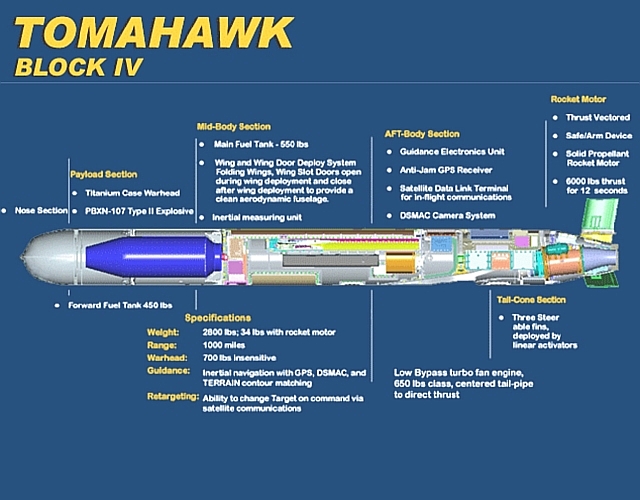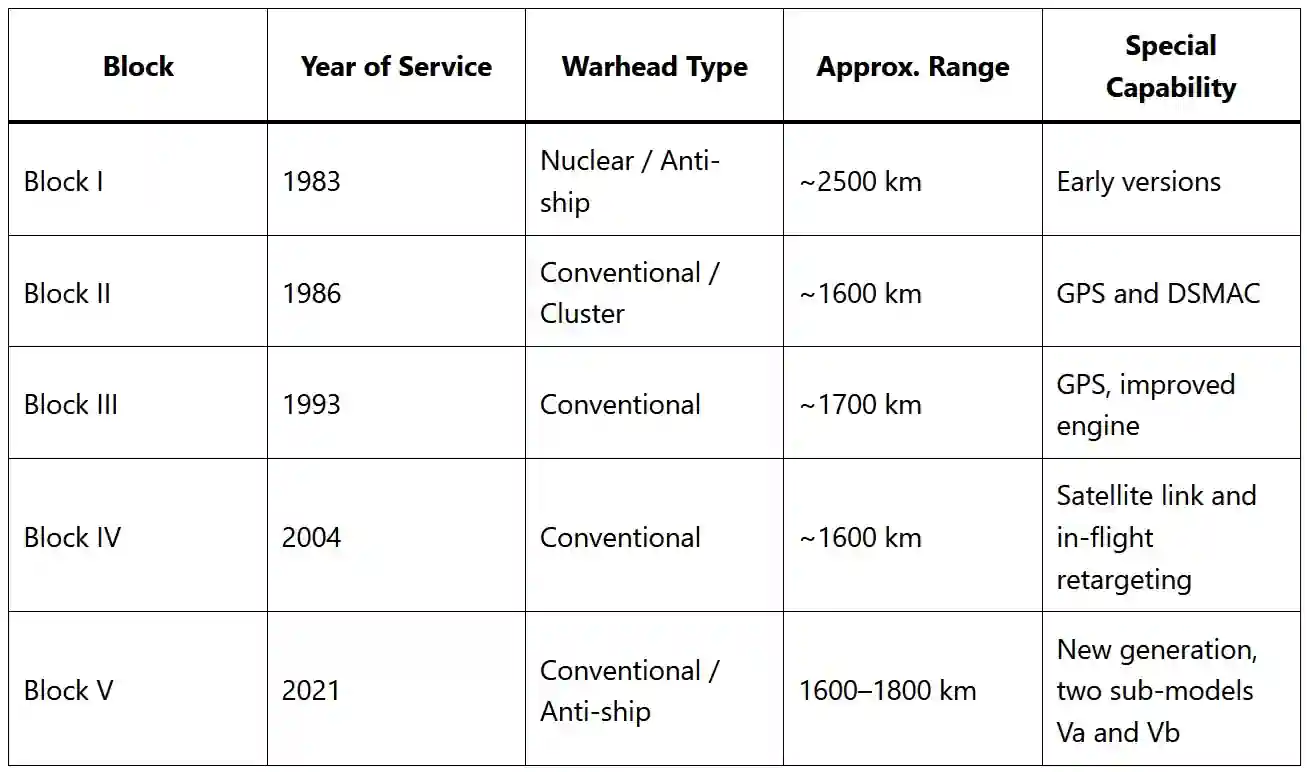Originally published by IslamicWorldNews
The Tomahawk is a subsonic, long-range, precision-guided cruise missile launched from submarines and surface platforms. Designed for deep land strikes and targeting high-value assets, it has become a cornerstone of U.S. military strike operations over the past half-century. Its ability to fly at low altitude, employ advanced combined guidance systems, and—on modern variants—retarget mid-flight, makes it a highly versatile and reliable weapon.
Design and Development History
Development of the Tomahawk began in the 1970s under General Dynamics, with the goal of producing a sea-land cruise missile capable of penetrating deep into enemy territory. The first versions entered U.S. Navy service in the 1980s, and since then the missile has undergone multiple generations and block upgrades. Companies such as McDonnell Douglas, Hughes, and ultimately Raytheon took responsibility for its continued development and modernization. Over time, guidance technologies (TERCOM, DSMAC, GPS) and communication capabilities were added, enabling not only high accuracy but also in-flight target changes and loitering around designated areas. Newer versions like Block IV and V introduced network-centric features, two-way communication, and retargeting capabilities, significantly enhancing operational effectiveness. The Tomahawk’s role in conflicts such as Operation Desert Storm, the Balkan bombings, and later campaigns cemented its status as a symbol of U.S. naval strike power.
As noted, Raytheon is the primary contractor for Tomahawk production, but manufacturing requires collaboration with dozens of suppliers and subcontractors across the United States and allied nations. The accompanying illustration highlights the key partners and suppliers involved in the missile’s production within the U.S.
Dimensions and Aerodynamic Features of the Tomahawk Missile
The Tomahawk is a missile with a cylindrical body and foldable wings, designed for launch from vertical launch systems (VLS) or submarine torpedo tubes. The general dimensions of the Tomahawk cruise missile are reported as follows: length approximately 5.5 to 6.25 meters (depending on variant and booster), diameter about 52 centimeters, and launch weight in the range of 1,200–1,350 kilograms.
After exiting the launch tube, the missile’s wings unfold to provide the aerodynamic characteristics required for low-level flight. The Tomahawk’s body is constructed from lightweight yet durable alloys, optimized for low-altitude penetration and radar evasion. Its design enables it to remain undetected by radar systems while navigating complex flight paths to bypass enemy air defenses.
Internal Components of the Tomahawk Missile
In general, the Tomahawk consists of several main sections: the guidance and navigation system, the warhead, the fuel tank, the engine, and the booster. It should be noted that the placement of these components varies depending on the specific model of the missile.
– Guidance and Navigation System
The Tomahawk missile employs a hybrid guidance system. Its navigation suite includes INS for initial navigation, GPS for enhanced positional accuracy along the route, and TERCOM and DSMAC for terrain and terminal guidance.
TERCOM (Terrain Contour Matching) operates during the mid-course phase of flight. The missile stores preloaded TERCOM and DSMAC terrain maps in its memory and compares them with altimeter readings and inertial navigation data to detect and correct deviations. This method is particularly effective for low-level flight over uneven terrain and provides resilience against satellite interference such as GPS jamming.
DSMAC (Digital Scene Matching Area Correlation) is used in the terminal phase for final target acquisition. A nose-mounted camera captures real-time imagery of the target area and compares it with stored reference images, enabling precise target location and final flight corrections. This technology significantly improves strike accuracy and allows for pinpoint targeting.
The Block IV and Block V variants of the Tomahawk are equipped with a two-way data link, enabling in-flight retargeting, transmission of imagery, and operator-directed course changes. This enhanced guidance suite allows the missile to achieve accuracy within just a few meters (low CEP) and significantly improves its ability to penetrate heavily defended airspace.
– Warhead
The warhead is located in the forward section of the missile. Most Tomahawk variants are equipped with a high-explosive warhead weighing around 310 kilograms, containing approximately 120 kilograms of PBXN-107 explosive material. This configuration is designed to destroy buildings, infrastructure, and other high-value targets. Certain versions have also been produced with specialized or anti-ship warheads tailored for specific missions.
– Fuel Tank
The fuel tank is positioned in the central body section and is engineered to provide the long range required for operations. The exact fuel capacity varies depending on the missile’s configuration and model.
– Propulsion and Booster
For launch from surface platforms or submarines, the Tomahawk uses a solid-fuel booster that accelerates the missile to the speed necessary for its turbofan engine. Once the booster separates, the main engine takes over, managing thrust and fuel consumption. This design enables launches from confined submarine tubes or vertical launch systems (VLS) aboard warships. The Tomahawk’s flight is powered by a compact liquid-fuel turbofan engine, typically from the Williams F107 family or similar equivalents, providing speeds in the range of 880 to 920 kilometers per hour.
Variants of the Tomahawk Missile
To begin with, the Tomahawk missile is designated within the U.S. Armed Forces nomenclature system under the identifiers RGM-109, UGM-109, and BGM-109. The first letter in the code indicates the launch platform: RGM for surface-ship launch, UGM for submarine launch, and BGM-109 for ground-based launchers. The letter following the number (A, B, C, D, E) denotes the configuration and generation of the missile.
BGM-109A TLAM-N (Block I): This was the first operational model of the Tomahawk, equipped with a nuclear warhead, and entered service in the 1980s. The TLAM-N carried the W80 warhead with variable yield (5 to 200 kilotons) and could be launched from surface ships using armored box launchers (now retired) as well as from submarines. Developed under Block I, it had a range of about 2,500 kilometers and was designed for strategic strikes during the Cold War. Following arms reduction treaties, this nuclear-armed variant was retired in the 1990s.
On the missile’s designation: Initially, since the Tomahawk was being developed for multiple platforms—land, sea, and submarine—the general code BGM-109 was assigned, with the prefix “B” marking it as the first missile of this family. This designation remained in official records, even though the missile was never operationally deployed or launched from land-based systems.
BGM-109G Gryphon: This variant was developed specifically for the U.S. Air Force and launched from mobile ground-based platforms. The Gryphon carried a W84 nuclear warhead and had a range of approximately 2,780 kilometers. It was deployed in Europe to strengthen deterrence against the Soviet Union. Following the signing of the INF Treaty in 1987, all medium-range ground-launched missiles, including the Gryphon, were retired from service.
RGM/UGM-109B TASM (Block I) This Tomahawk variant, with a range of 460 kilometers, was designed for anti-ship missions and developed under Block I. The TASM utilized active radar guidance and was intended for long-range attacks against enemy vessels. With the introduction of more advanced anti-ship missiles such as the Harpoon and NSM, this model was retired in 1994 and converted into the TLAM-E Block IV version.
RGM/UGM-109C TLAM-C (Block II and Block III): This variant was developed with a conventional warhead and enhanced navigation through the addition of TERCOM and DSMAC systems for greater accuracy. The TLAM-C initially carried the WDU-25/B warhead, weighing 450 kilograms and containing 171 kilograms of powerful explosives (Picratol and H-6 composite). Its operational range was about 1,300 kilometers.
From 1993 onward, the WDU-25/B was replaced with the lighter WDU-36/B warhead, weighing 310 kilograms and containing 120 kilograms of PBXN-107 high explosive. The reduced warhead size allowed for a larger fuel tank, extending the maximum range to 1,700 kilometers. This upgraded version was designated TLAM-C Block III. It became one of the most widely used Tomahawk models in U.S. military operations in recent decades.
RGM/UGM-109D TLAM-D (Block III): This model was developed under Block III and designed to carry a cluster warhead. The TLAM-D was equipped with 166 BLU-97/B submunitions, which were released at a designated altitude above the target. It was intended for strikes against wide-area targets such as airfields and military concentrations. The range of this version was reported to be around 1,300 kilometers. Cluster-armed Tomahawk missiles are no longer in service, as they were converted to unitary warhead configurations.
Block IV (RGM/UGM-109E / TLAM-E): Block IV marked a major milestone in the evolution of the Tomahawk. The TLAM-E is an upgraded version of the TLAM-C Block III and was introduced in 2004. TLAM-E Block IV missiles feature an improved turbofan engine that allows them to reduce fuel consumption during flight and adjust their speed as needed.
This version is equipped with electro-optical sensors and a two-way satellite data link with the command center, enabling it to receive updated information during flight and redirect toward new targets. The electro-optical sensors can transmit imagery back to command via satellite, allowing real-time battle damage assessment, even moments before impact.
Additionally, this variant has the ability to loiter over an area, return toward the launch region, and be retargeted as needed. With reduced production costs and enhanced operational flexibility, Block IV has become one of the most effective Tomahawk versions. Its reported range is approximately 1,600 kilometers.
Block V: This block is the latest Tomahawk variant, developed in recent years and entering U.S. Navy service in 2021. The Block V (baseline) is an upgraded version of Block IV, featuring new communication systems, electronic warfare enhancements, improved accuracy, network-centric capabilities, and the ability to strike moving maritime targets such as ships.
Block V is divided into two sub-models: Block Va (MST) which is the anti-ship variant with a range of 500–700 kilometers; and Block Vb (JMEWS) which is quipped with a penetrating warhead for land-attack missions and destruction of hardened targets. The range of this version is reported to be between 1,600 and 1,800 kilometers.
In 2020, the spokesperson for the U.S. Navy’s Tomahawk program announced that all Block IV Tomahawks would be upgraded to the Block V standard, while the remaining Block III missiles would gradually be retired and decommissioned.
In summary, the evolution of Tomahawk missiles is shown in the table below:

Tomahawk Missile Launch Platforms
The Tomahawk cruise missile is designed to be launched from multiple platforms. Below, the different launch systems for this missile are described in detail.
– Naval Launchers
Tomahawk missiles are widely launched from U.S. Navy surface warships such as Arleigh Burke-class destroyers and Ticonderoga-class cruisers. These vessels are equipped with the Vertical Launch System (VLS), which enables rapid missile firing. Each VLS cell can house a single Tomahawk missile. Due to their quick readiness and ability to fire multiple missiles simultaneously, these launchers play a critical role in offensive operations.
– Submarine Launchers
Los Angeles-class, Virginia-class, and Ohio-class submarines are capable of launching Tomahawk missiles. In Ohio-class submarines, the missiles are fired through vertical launch systems integrated into the hull, while in Los Angeles-class and Virginia-class submarines, they are launched through torpedo tubes. Launching from submarines provides the advantages of stealth and surprise, enabling strikes from positions hidden from the enemy’s view.
– Land-based Launchers
During the Cold War, the land-based version of the Tomahawk, known as the BGM-109G Gryphon, was developed by the U.S. Air Force. This missile was launched from mobile ground-based Transporter Erector Launchers (TEL) and deployed in Europe. The Gryphon was equipped with a nuclear warhead and designed for strategic strikes against targets within Soviet territory. With the signing of the INF Treaty in 1987, this variant and its land-based launchers were retired from service.
Important Note on Tomahawk Launchers: Although the land-based version of the Tomahawk, the BGM-109G, was retired, naval Tomahawk missiles can still be prepared for launch using Mk-41 vertical launchers mounted on trailers. This approach effectively bypasses the restriction on ground-based deployment of the missile. The U.S. military addressed this issue through the Typhon project, also known as the “Strategic Mid-Range Fires System” (SMRF).
Each Typhon missile system consists of four Mk-41 vertical launch boxes installed within a 12-meter ISO container. These launchers are capable of firing both SM-6 standard missiles and Tomahawk cruise missiles.
Operational History of the Tomahawk Missile
Since entering service in 1983, the Tomahawk cruise missile has played a key role in numerous military operations conducted by the United States and its allies.
Persian Gulf War (1991): The first large-scale use of the Tomahawk occurred during Operation Desert Storm against Iraq. More than 288 missiles were launched from U.S. ships and submarines, striking targets such as command centers, air defense sites, and military facilities.
Balkans (1995–1999): During NATO operations against Yugoslavia, Tomahawks were used to attack Serbian army positions, radar stations, and communication infrastructure. These strikes significantly weakened Belgrade’s military capabilities.
Sudan and Afghanistan (1998): In response to the bombings of U.S. embassies in Kenya and Tanzania, the United States launched about 75 Tomahawks against the Al-Shifa pharmaceutical plant in Khartoum, Sudan—alleged to be involved in chemical weapons production—and against al-Qaeda training camps in Khost, Afghanistan.
Afghanistan War (2001): At the start of Operation Enduring Freedom, more than 50 Tomahawks targeted al-Qaeda training camps, Taliban hideouts, and command centers in Afghanistan’s mountainous regions.
Iraq War (2003): During Operation Iraqi Freedom, over 725 Tomahawks were fired. These strikes extensively targeted military infrastructure, command centers, and Saddam Hussein’s shelters. The use of Tomahawks in this war became a hallmark of “precision warfare.”
Yemen (2010–2020): As part of the campaign against al-Qaeda in the Arabian Peninsula (AQAP), the United States employed Tomahawks to strike hideouts and training camps in the provinces of Shabwah, Ma’rib, and Hadhramaut.
Libya (2011): In NATO’s operation to enforce a no-fly zone and support rebel forces, more than 112 Tomahawks were launched against Libyan air defense sites and command centers.
Syria (2017 and 2018): The United States, citing alleged use of chemical weapons by the Syrian government, employed Tomahawks in two strikes. In 2017, 59 missiles targeted the Shayrat airbase, and in 2018, over 100 missiles struck research facilities in Damascus and Homs.
Yemen (2025): Amid the Red Sea crisis and U.S. support for Israel, the United States and the United Kingdom launched more than 35 Tomahawks against Ansar Allah positions in Yemen.
Iran (2025): On June 22, 2025, the United States, in a joint operation with Israel, carried out a major strike on Iran’s nuclear facilities at Fordow, Natanz, and Isfahan. 30 Tomahawks were launched from a U.S. Navy Ohio-class submarine against Natanz and the Isfahan nuclear site.
Defensive Interceptions: In several of these operations, air defense systems successfully intercepted or diverted Tomahawk missiles. For example, during the 2025 U.S. strike on Iran, some missiles were shot down by Iranian defense systems. This was confirmed through images of Tomahawk wreckage recovered after the attacks.
Export Market and Countries Operating the Tomahawk Missile
The export market for the Tomahawk cruise missile is highly restricted and tightly controlled by the United States, as the weapon is considered a strategic asset. To date, only a few close U.S. allies have been able to acquire or place orders for the missile. The United Kingdom was the first and remains the only foreign country to operate the submarine-launched version of the Tomahawk, which it has employed in military operations. Australia and Japan have, in recent years, signed contracts to purchase Block V variants to enhance the offensive capabilities of their naval fleets. Poland and Canada have also expressed interest in acquiring the missile and have engaged in negotiations.
In 2025, the Ukrainian government publicly requested Tomahawk cruise missiles from the United States to strengthen its offensive capability against strategic targets in Russian territory. The Pentagon approved the transfer of Tomahawks to Ukraine, but the final decision was left to the U.S. President.
With an export price of approximately $4 million (export version) per missile and given the geopolitical sensitivities, Tomahawk exports remain limited to nations with close security ties to Washington.
Final Summary
With features such as long range, high accuracy, sea-launch capability, in-flight retargeting, and flexibility in carrying different warheads, the Tomahawk is one of the most effective long-range offensive weapons in the U.S. arsenal. Beyond its battlefield role, it plays a vital part in U.S. deterrence doctrine and military power projection. The development of new, network-enabled versions ensures the missile’s continued relevance in current conflicts and for decades to come.
Type: Long-range subsonic cruise missile
Origin: United States
Manufacturer: Raytheon
Service Entry: 1983
Length: 5.56 meters
Wingspan: 2.67 meters
Diameter: 0.52 meters
Weight: 1,300 kilograms
Engine: F107-WR-402 turbofan
Range: 1,600 + kilometers (Block V)
Flight Altitude: 30–50 meters AGL
Speed: 920 km/h (Mach 0.74)
Warhead: 120 kg PBXN-107 high explosive
Guidance Systems: GPS, INS, TERCOM, DSMAC, ARH
MORE ON THE TOPIC:





























whack @ss, weak @ss army b/s.
tomahawks coming to moscow soon…maybe with a nuclear warhead…heheheh
and how many times have you said that b/s
don’t worry, there’s an oreshnik aimed right at his office on the rue de la fusée in brussels. it will get there much faster…..
i hope so. this needs to escalate.
the us is well practiced at using these very destructive nuclear capable weapons in concert with troops. nato is dangerous
shitty american “weapon of choice”… amerikunts don´t have balls to invade venezuela! lmao! southfront based in langley still giving honors to these loosers!
the tomahawk is much less effective today then it was during the american invasion of afghanistan and iraq. those countries did not have modernized anti air and anti missile capabilities.
when they were used against syria many were shot down before reaching their targets as syria had proper air defences supplied by russia.
russians themselves are better equiped to deal with this weapon now then they were in the past its effect in ukraine will be limited.
polymarket propaganda in southfront site? cui buono? lmao… you are really “amazing”… this kind of “russians” is what led russia to the dark years… liberals always be the cancer of russia!
no baba jaga inside